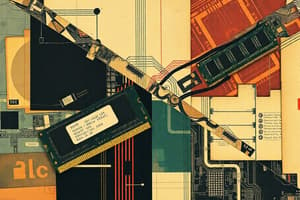Podcast
Questions and Answers
What does RAM primarily refer to in the context of computer memory?
What does RAM primarily refer to in the context of computer memory?
- High-speed temporary storage (correct)
- Backup memory module
- Long-term storage data
- A type of hard drive
What is the purpose of the memory slots in a computer?
What is the purpose of the memory slots in a computer?
- To install a CPU
- To hold RAM modules and facilitate data transfer (correct)
- To store the operating system
- To connect external storage devices
Why is it important to consult motherboard documentation when selecting memory?
Why is it important to consult motherboard documentation when selecting memory?
- To find out the speed of the installed SSD
- To understand how to install a CPU
- To determine the maximum storage capacity of the motherboard
- To identify the compatible type of memory modules (correct)
What does DIMM stand for in the context of memory modules?
What does DIMM stand for in the context of memory modules?
What is the data width used for transferring information in and out of DIMMs?
What is the data width used for transferring information in and out of DIMMs?
How are DIMMs secured in the memory slots of a motherboard?
How are DIMMs secured in the memory slots of a motherboard?
What distinguishes a SO-DIMM from a standard DIMM?
What distinguishes a SO-DIMM from a standard DIMM?
What happens when information is loaded onto RAM?
What happens when information is loaded onto RAM?
What is the main function of the clock in a computer system regarding memory modules?
What is the main function of the clock in a computer system regarding memory modules?
What is the primary characteristic of dynamic random access memory (D-RAM)?
What is the primary characteristic of dynamic random access memory (D-RAM)?
Which memory type allows for double data rate in a single clock cycle?
Which memory type allows for double data rate in a single clock cycle?
What do the notches on the memory modules prevent?
What do the notches on the memory modules prevent?
What is the maximum RAM capacity per module for DDR4 memory?
What is the maximum RAM capacity per module for DDR4 memory?
Which memory version is identified as 'DDR3' and what is its significant improvement over DDR2?
Which memory version is identified as 'DDR3' and what is its significant improvement over DDR2?
Why is there no backward compatibility between different DDR memory types?
Why is there no backward compatibility between different DDR memory types?
What is the key characteristic of SO-DIMMs compared to standard DIMMs?
What is the key characteristic of SO-DIMMs compared to standard DIMMs?
What type of memory does not retain data when power is off?
What type of memory does not retain data when power is off?
Which statement about DDR5 memory is true?
Which statement about DDR5 memory is true?
Flashcards
RAM
RAM
The type of memory commonly used in personal computers for temporary storage of applications and data.
Memory modules
Memory modules
Physical memory modules that are installed on the motherboard and provide temporary storage for data and programs.
Memory slots
Memory slots
A type of memory slot designed for fast data transfer between the memory modules and the CPU.
DIMM
DIMM
Signup and view all the flashcards
SO-DIMM
SO-DIMM
Signup and view all the flashcards
Data width
Data width
Signup and view all the flashcards
DIMM installation
DIMM installation
Signup and view all the flashcards
Memory clips
Memory clips
Signup and view all the flashcards
Synchronous DRAM (SDRAM)
Synchronous DRAM (SDRAM)
Signup and view all the flashcards
Double Data Rate (DDR) SDRAM
Double Data Rate (DDR) SDRAM
Signup and view all the flashcards
Memory Module Notch
Memory Module Notch
Signup and view all the flashcards
RAM Capacity per Module
RAM Capacity per Module
Signup and view all the flashcards
DDR3 SDRAM
DDR3 SDRAM
Signup and view all the flashcards
DDR4 SDRAM
DDR4 SDRAM
Signup and view all the flashcards
DDR5 SDRAM
DDR5 SDRAM
Signup and view all the flashcards
Backwards Compatibility of Memory
Backwards Compatibility of Memory
Signup and view all the flashcards
DRAM Refresh
DRAM Refresh
Signup and view all the flashcards
Study Notes
RAM (Random Access Memory)
- RAM is the high-speed, temporary storage used when loading applications and documents.
- RAM is distinct from hard drive or SSD storage.
- It's stored in memory modules (DIMMs or SO-DIMMs).
Memory Modules (DIMMs and SO-DIMMs)
- DIMMs (Dual Inline Memory Modules) have connectors on opposite sides, enabling 64-bit data transfers.
- SO-DIMMs (Small Outline DIMMs) are smaller, half the width of DIMMs, common in laptops and mobile devices.
- Memory modules are installed into specific slots on the motherboard. Clips secure the module.
- Notches on the bottom of the modules prevent incorrect installation (e.g., DDR2 in a DDR3 slot).
RAM Types and Speeds
- RAM is dynamically refreshed (D-RAM), needing a continuous power source.
- Accessing data is random; any part can be accessed directly.
- Synchronous RAM is regulated by a system clock, synchronizing data transfer.
- Older systems (single data rate) transfer one bit per clock cycle.
- Modern systems (double data rate - DDR) transfer two bits per clock cycle.
- DDR3 memory is faster than DDR2.
- DDR4 memory is faster than DDR3 and allows for 64 gigabytes per module.
- DDR5 memory is faster than DDR4, with the same 64 GB maximum per module.
- Different DDR types are not backward compatible.
Studying That Suits You
Use AI to generate personalized quizzes and flashcards to suit your learning preferences.




